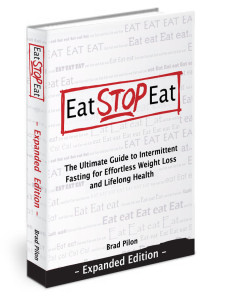Maybe you’ve heard about Intermittent Fasting (IF) or Calorie Restriction in some form. There is a buzz about it. But the most important thing to know about Intermittent Fasting is that it isn’t a “diet” – it’s a way of eating, a nutritional lifestyle that can enable you to reach your health and body goals in an efficient and convenient manner. IF also enables you to hold onto your physique and your fitness if you’re an athlete.
IF doesn’t require following any particular dietary “style”. So you can use IF whether you’re Vegan, Paleo, Meat-n-Potatoes or Gluten-Free… It doesn’t matter. Although, here at Vital Endurance, we advocate for Clean Nutrition whenever you do feed yourself. So if your lifestyle isn’t all that healthy yet, you need to read the Vital Endurance ebook first. Otherwise…
The basic premise of IF is to enjoy better health via repeatedly fasting for longer periods than is typical on an everyday breakfast-lunch-dinner schedule. It’s done by skipping meals or going certain days without food in a somewhat systematic manner. Benefits can begin in as few as 12 hours.
QUICK PAUSE…If you already know you want to adopt an Intermittent Fasting eating plan, just go right away and check out the best book on the subject by Brad Pilon called Eat Stop Eat.
It’s an eBook that you can download and get started with right away. In case you need more justification, read on…
How Does It Work?
An IF regime works, because it aligns with our evolutionary history. Over the 250,000 years that Homo sapiens have been around, food supply has waxed and waned. We evolved to take advantage of this fact, building muscle and tissue during times of abundance, then paring it back during lean ones. Fasting periods accelerate the clearing-out of waste left by dead and damaged cells, a process known as autophagy. A failure of autophagy to keep up with accumulated cellular debris is believed by many scientists to be one of the major causes of the chronic diseases associated with aging.
If you’re looking for the quick bullet points of IF benefits, check these out:
- The body’s insulin sensitivity is improved with fasting – especially when paired with exercise.
- There are hormonal benefits that lead to improved body composition such as an increase in the secretion of Growth Hormone which enables you to lose fat and gain muscle. Growth Hormone also tends to offset the effects of cortisol, which is (in part) related to belly fat storage; so it seems likely that fasting can help you with belly fat specifically.
- Fasting reduces inflammation, which can have implications for improved immunity as well as increased fat loss.
- By restricting calories, you’re forcing the body to look elsewhere than the gut for energy, which can encourage cellular repair. That is, a cell will turn to its own damaged proteins for energy. While that cycle would be bad in the long term – since you’re only fasting for brief periods, when you eat again the cell will use the new “stuff” to replace the old “stuff” that’s been consumed. This can generally help prevent both disease and ageing.
- Occasional fasting also seems to boost activity and growth of certain types of cells, especially neurons. This may seem odd, but consider it from an evolutionary perspective – when food is scarce, natural selection would favor those whose memories (“Where have we found food before?”) and cognition (“How can we get it again?”) became sharper.
Benefits for Athletes
Okay, so you’re already pretty fit and you eat well. Can IF still give benefits? Consider this… Athletes have always been “taught” that the body’s fuel source is glucose – blood sugar. We must get it in abundance by eating sugar and refined carbohydrates like bread, pasta, and sports drinks. But our body can burn another type of fuel known as ketones. These molecules are created when your body runs out of glucose and in a process called ketosis it starts to burn fat. This happens automatically when you fast. Your system switches fuel sources from sugar to fat without breaking down muscle.
The human body appears to be adapted to thrive during short bouts of going without food. A short effort – around 45 minutes – of moderate exercise like strength training or bike riding can run your body through its blood glucose stores and turbocharge ketosis. But like anything, it takes some work – especially for the body of a finely tuned athlete with high energy demands. You do need to adapt your body to this fat-burning ketosis, and it’s best to do it in a systematic way. It is called Intermittent Fasting, NOT haphazard fasting…and there’s a reason for it.
Again, if you really want to get into it and learn all the details, the best resource that is presented in an easy-to-follow format is certainly Eat Stop Eat by Brad Pilon. It’s simple and concise yet also backed up with tons of references and updated, cutting-edge scientific research.
To Your Health!
[grwebform url=”https://app.getresponse.com/view_webform_v2.js?u=S7bW&webforms_id=1811502″ css=”on” center=”off” center_margin=”200″/]






